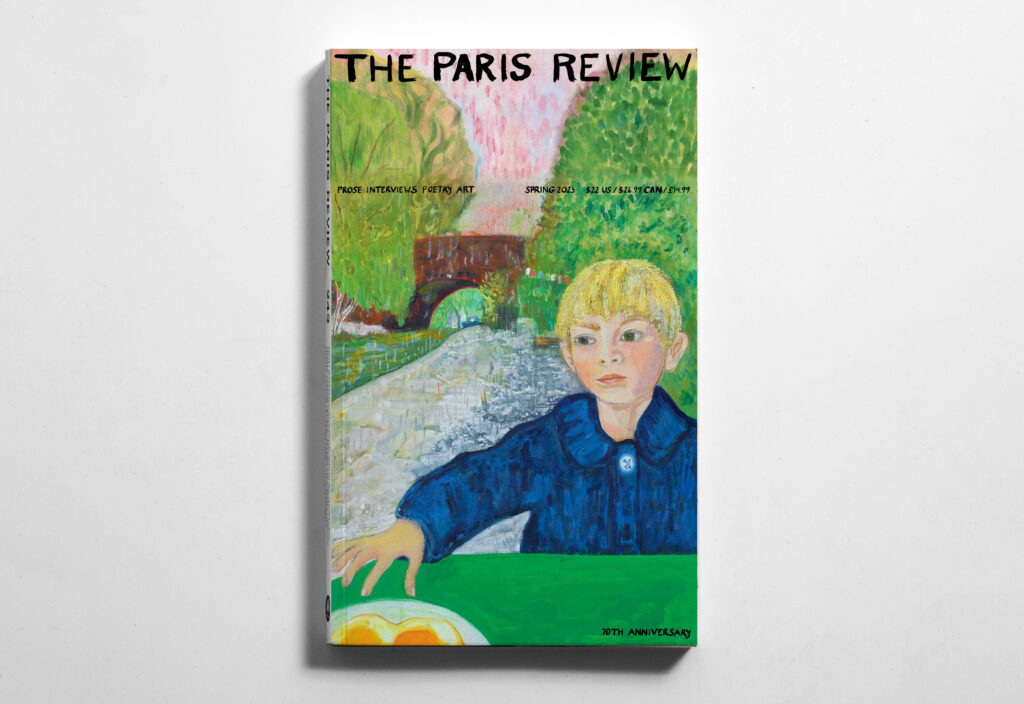The Review Celebrates Seventy with Fried Eggs by the Canal

Peter Doig, Canal Painting, 2022–2023, on the cover of issue no. 243. © Peter Doig. Courtesy of the artist and TRAMPS; photograph by Prudence Cuming.
For the cover of our seventieth-anniversary issue, we commissioned a painting by the artist Peter Doig, of a boy eating his breakfast beside a London canal. Our contributing editor Matthew Higgs spoke with Doig about his influences and fried eggs.
INTERVIEWER
How did the cover image come about?
PETER DOIG
I’d made a birthday card for my son Locker—a more cartoony version of what became the painting. I quite liked the subject: he’s sitting at a café on the towpath of the canal in East London. Everyone who knows London knows the canal—we take it for granted. I can’t think of any paintings of it, but it seems to me a sort of classic painting subject.
I started working on the image alongside a big painting I was making for an exhibition at the Courtauld. I was thinking about how my work relates to the Impressionist galleries there, which contain Cézanne, Gauguin, Daumier, Van Gogh, Seurat, et cetera. I had begun many of the paintings before I was invited to make the exhibition, but most of them had a long, long way to go before being finished. I’d brought all my paintings to my London studio from New York and Trinidad, and all of a sudden I had more paintings in progress than I think I’d had in probably thirty-odd years. It was quite exciting in a way, but then I had to make an edit, to decide which ones I was going to concentrate on, because I was getting carried away and I was never going to finish everything. The canal painting was the one very, very new one. That’s why I liked it for the Review—and because, although I thought of the image as very much a London painting, somehow after I made it I was reminded of Paris, and of French painting more than of English painting.
INTERVIEWER
Is it important that the viewer knows the boy is your son?
DOIG
Perhaps for people who know him. I’ve got quite a large family, and so it’s important to me that when I make a painting that depicts one of my children, the others can relate to it and feel that they understand why I did it. In the painting of Locker, I wanted to capture a person at that stage in life, the way Cézanne did when he used his son as a model. Another one of the paintings in the Courtauld exhibition features my daughter Alice in a hammock surrounded by greenery. I began working on the painting in 2014—I know that because I recently found a photograph of Alice standing in her primary school uniform looking at it when I very first started it. I finished it this year in my studio in just a few hours, after having returned to it after all those years. One of my other kids saw it and said that I had absolutely captured Alice at that age. That’s why I left it not quite finished, with translucent tones—I wanted it to feel almost ghostly. She’s now a grown woman, and it captures the passage of time.
INTERVIEWER
What’s the significance of the canal?
DOIG
The canal, up until fairly recently, was a place of dread. After the industrial revolution, the canal no longer served the buildings on it, so for a long time stepping onto the towpath at night meant risking a mugging or worse. That has changed and is changing. The painting’s setting is a real café very close to where we live at present, and where I’ve spent quite a bit of time over the last few years, looking westward at the view through the bridge. Sitting there I realized how beautiful it is, and how much like a painting it is already. I also thought of paintings by Manet and others—paintings of railways and train stations, with figures in the foreground.
INTERVIEWER
The Impressionists painted some of the earliest depictions of what we understand as modernity.
DOIG
I was looking at Manet’s painting A Bar at the Folies-Bergère. Behind the girl at the bar, there are two globes in the background, two spheres. It’s not obvious at first, but they are electrical lights, and Manet painted them in very, very sharp focus, whereas everything else in the painting is quite blurred. I suppose at the time Manet made the painting the viewer would have been really surprised by this very modern element entering a work of art. In my painting, the eggs are a bit like that—in a way, the eggs are the most contemporary thing in the painting.
Matthew Higgs is a contributing editor of The Paris Review.
Copyright
© The Paris Review
